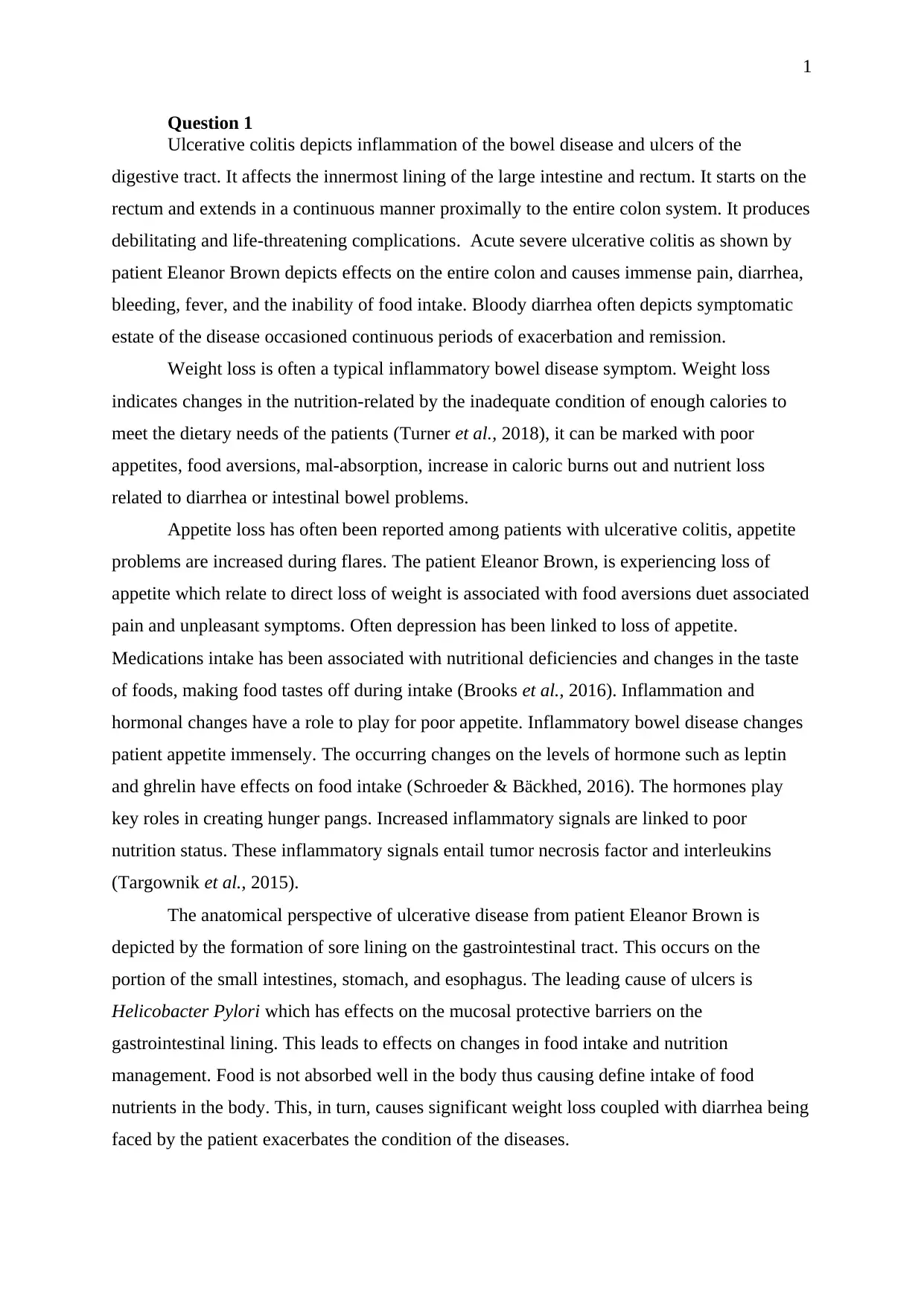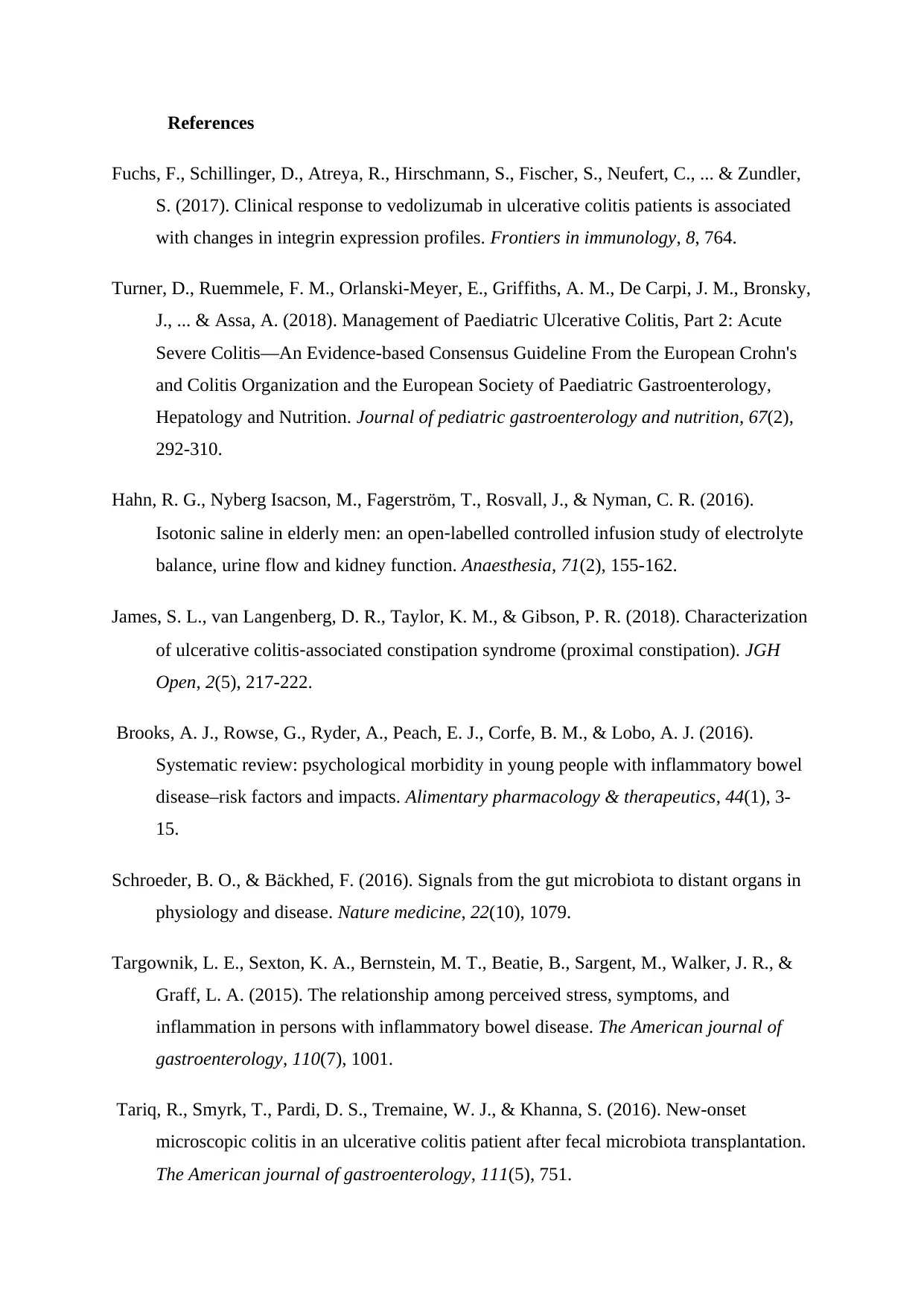Ulcerative Colitis: Symptoms, Causes, and Management
VerifiedAdded on 2023/04/08
|6
|1352
|268
AI Summary
This case study assessment provides a comprehensive overview of ulcerative colitis, including its symptoms, causes, and management. It explores the impact of weight loss, loss of appetite, and the anatomical perspective of the disease. The study also discusses the use of morphine tablets for pain relief and the role of Hartman solution in managing low blood volume. References are included for further reading.
Contribute Materials
Your contribution can guide someone’s learning journey. Share your
documents today.

Case study assessment
Name
University
Tutor
Date
Name
University
Tutor
Date
Secure Best Marks with AI Grader
Need help grading? Try our AI Grader for instant feedback on your assignments.

1
Question 1
Ulcerative colitis depicts inflammation of the bowel disease and ulcers of the
digestive tract. It affects the innermost lining of the large intestine and rectum. It starts on the
rectum and extends in a continuous manner proximally to the entire colon system. It produces
debilitating and life-threatening complications. Acute severe ulcerative colitis as shown by
patient Eleanor Brown depicts effects on the entire colon and causes immense pain, diarrhea,
bleeding, fever, and the inability of food intake. Bloody diarrhea often depicts symptomatic
estate of the disease occasioned continuous periods of exacerbation and remission.
Weight loss is often a typical inflammatory bowel disease symptom. Weight loss
indicates changes in the nutrition-related by the inadequate condition of enough calories to
meet the dietary needs of the patients (Turner et al., 2018), it can be marked with poor
appetites, food aversions, mal-absorption, increase in caloric burns out and nutrient loss
related to diarrhea or intestinal bowel problems.
Appetite loss has often been reported among patients with ulcerative colitis, appetite
problems are increased during flares. The patient Eleanor Brown, is experiencing loss of
appetite which relate to direct loss of weight is associated with food aversions duet associated
pain and unpleasant symptoms. Often depression has been linked to loss of appetite.
Medications intake has been associated with nutritional deficiencies and changes in the taste
of foods, making food tastes off during intake (Brooks et al., 2016). Inflammation and
hormonal changes have a role to play for poor appetite. Inflammatory bowel disease changes
patient appetite immensely. The occurring changes on the levels of hormone such as leptin
and ghrelin have effects on food intake (Schroeder & Bäckhed, 2016). The hormones play
key roles in creating hunger pangs. Increased inflammatory signals are linked to poor
nutrition status. These inflammatory signals entail tumor necrosis factor and interleukins
(Targownik et al., 2015).
The anatomical perspective of ulcerative disease from patient Eleanor Brown is
depicted by the formation of sore lining on the gastrointestinal tract. This occurs on the
portion of the small intestines, stomach, and esophagus. The leading cause of ulcers is
Helicobacter Pylori which has effects on the mucosal protective barriers on the
gastrointestinal lining. This leads to effects on changes in food intake and nutrition
management. Food is not absorbed well in the body thus causing define intake of food
nutrients in the body. This, in turn, causes significant weight loss coupled with diarrhea being
faced by the patient exacerbates the condition of the diseases.
Question 1
Ulcerative colitis depicts inflammation of the bowel disease and ulcers of the
digestive tract. It affects the innermost lining of the large intestine and rectum. It starts on the
rectum and extends in a continuous manner proximally to the entire colon system. It produces
debilitating and life-threatening complications. Acute severe ulcerative colitis as shown by
patient Eleanor Brown depicts effects on the entire colon and causes immense pain, diarrhea,
bleeding, fever, and the inability of food intake. Bloody diarrhea often depicts symptomatic
estate of the disease occasioned continuous periods of exacerbation and remission.
Weight loss is often a typical inflammatory bowel disease symptom. Weight loss
indicates changes in the nutrition-related by the inadequate condition of enough calories to
meet the dietary needs of the patients (Turner et al., 2018), it can be marked with poor
appetites, food aversions, mal-absorption, increase in caloric burns out and nutrient loss
related to diarrhea or intestinal bowel problems.
Appetite loss has often been reported among patients with ulcerative colitis, appetite
problems are increased during flares. The patient Eleanor Brown, is experiencing loss of
appetite which relate to direct loss of weight is associated with food aversions duet associated
pain and unpleasant symptoms. Often depression has been linked to loss of appetite.
Medications intake has been associated with nutritional deficiencies and changes in the taste
of foods, making food tastes off during intake (Brooks et al., 2016). Inflammation and
hormonal changes have a role to play for poor appetite. Inflammatory bowel disease changes
patient appetite immensely. The occurring changes on the levels of hormone such as leptin
and ghrelin have effects on food intake (Schroeder & Bäckhed, 2016). The hormones play
key roles in creating hunger pangs. Increased inflammatory signals are linked to poor
nutrition status. These inflammatory signals entail tumor necrosis factor and interleukins
(Targownik et al., 2015).
The anatomical perspective of ulcerative disease from patient Eleanor Brown is
depicted by the formation of sore lining on the gastrointestinal tract. This occurs on the
portion of the small intestines, stomach, and esophagus. The leading cause of ulcers is
Helicobacter Pylori which has effects on the mucosal protective barriers on the
gastrointestinal lining. This leads to effects on changes in food intake and nutrition
management. Food is not absorbed well in the body thus causing define intake of food
nutrients in the body. This, in turn, causes significant weight loss coupled with diarrhea being
faced by the patient exacerbates the condition of the diseases.

Question 2
Morphine tablet is essential for relieving short and long term pain. The release of the
capsule is effective in treating severe pain. It belongs to a group of drugs referred to narcotic
analgesics which acts on the nervous system with a key role to relieve pain in the body.
Morphine mechanism initiates through the exertion of the pain through analgesics and acting
mu-opioid receptors of the sensory neurons. The initiated binding leads to activation of mu-
opioid receptor activating associated G proteins. The subsequent action leads to inhibition of
adenylate cyclase, which reduces the level of intracellular cAMP. The G proteins are
activated by potassium channels and are inactivated by claims channels which cause a
decrease in the condition of the nerve and lowered neurotransmitter release thus blocking
pain signals.
Morphine being and alkaloid opium offers the most potent analgesics management of
chronic pain and uses less induction tolerance and has a high level of relaxing. Its mechanism
targets the receptors blocking pain signals in the body. Its administration is taken with
caution as it can leads to addictiveness thus cautious administration is undertaken (Fuchs et
al., 2017).
Question 3
Ptient Eleanor Brown Clinical manifestations of Ulcerative Colitis show effects on the
larger intestines and colons showing swelling and open sores. The state of the patient depicts
an increased state of intestinal perforations which requires urgent needs for total colostomy
and construction of an ileostomy.
The clinical symptoms are often related to abdominal pain, bloody stools, diarrhea,
fever, and rectal pain, depicting the key clinical features for the patient. Clinical diagnosis
entails stool test, endoscopy examination, colonoscopy, and ct scan. Status of blood tests is
essential in diagnosis UC (Tariq et al., 2016).
The key features are likely to exacerbate the patient status entail the occurrence of
diarrhea linked to bloody stool indicating the clear manifestation of an acute ulcerative
disease. Further, there are occurrences of pain and abdominal distension, pain causing a
burning sensation, weight loss and poor appetite affects patient status.
Further, changes on the patient Eleanor Brown vital status from normal levels to
lower levels indicates worsening of the disease state. Blood cell count reflects low blood
volume with the increase in white blood cells showing an increased infectious state of the
body. Further studies have indicated the relationship between food and the body ability to
protect itself and prevent other complications. Weight loss reflects the inability of the body to
Morphine tablet is essential for relieving short and long term pain. The release of the
capsule is effective in treating severe pain. It belongs to a group of drugs referred to narcotic
analgesics which acts on the nervous system with a key role to relieve pain in the body.
Morphine mechanism initiates through the exertion of the pain through analgesics and acting
mu-opioid receptors of the sensory neurons. The initiated binding leads to activation of mu-
opioid receptor activating associated G proteins. The subsequent action leads to inhibition of
adenylate cyclase, which reduces the level of intracellular cAMP. The G proteins are
activated by potassium channels and are inactivated by claims channels which cause a
decrease in the condition of the nerve and lowered neurotransmitter release thus blocking
pain signals.
Morphine being and alkaloid opium offers the most potent analgesics management of
chronic pain and uses less induction tolerance and has a high level of relaxing. Its mechanism
targets the receptors blocking pain signals in the body. Its administration is taken with
caution as it can leads to addictiveness thus cautious administration is undertaken (Fuchs et
al., 2017).
Question 3
Ptient Eleanor Brown Clinical manifestations of Ulcerative Colitis show effects on the
larger intestines and colons showing swelling and open sores. The state of the patient depicts
an increased state of intestinal perforations which requires urgent needs for total colostomy
and construction of an ileostomy.
The clinical symptoms are often related to abdominal pain, bloody stools, diarrhea,
fever, and rectal pain, depicting the key clinical features for the patient. Clinical diagnosis
entails stool test, endoscopy examination, colonoscopy, and ct scan. Status of blood tests is
essential in diagnosis UC (Tariq et al., 2016).
The key features are likely to exacerbate the patient status entail the occurrence of
diarrhea linked to bloody stool indicating the clear manifestation of an acute ulcerative
disease. Further, there are occurrences of pain and abdominal distension, pain causing a
burning sensation, weight loss and poor appetite affects patient status.
Further, changes on the patient Eleanor Brown vital status from normal levels to
lower levels indicates worsening of the disease state. Blood cell count reflects low blood
volume with the increase in white blood cells showing an increased infectious state of the
body. Further studies have indicated the relationship between food and the body ability to
protect itself and prevent other complications. Weight loss reflects the inability of the body to

utilize food and thus making weaker immune response deteriorating the patient status and
increasing the pain on the abdominal regions (James et al., 2018).
Question 4
Hartman solution has sodium chloride, sodium lactate, calcium chloride, potassium
chloride, and water. Its key function in the body is to offer to replenish of body fluids and lost
electrolytes among the low blood volume patients and low blood pressure indication (). The
clinical manifestations depicted by the patient reflect a state of low blood volume and
significantly lowered pressure (Titze, 2015).
Further, Hartman solution intervention application is key in managing acidosis. It
aids in fluid resuscitation due to low blood volume. It is essential due to its ability to
counteract acidosis related to a chemical imbalance due to acute fluid loss.
The key rational underlying the patient Eleanor Brown needs for the administration of
the fluid is beneficial for the rectification of the ions loss and to correct the electrolyte in the
body exacerbate by the frequent episodes of diarrhea which is draining the patient ions status.
Thus for patient Brown maintenance of electrolyte levels, there is a need for management of
fluid status which can have significant effects on the normal functioning of the body and
worsened the status of the patient (Hahn et al., 2016).
increasing the pain on the abdominal regions (James et al., 2018).
Question 4
Hartman solution has sodium chloride, sodium lactate, calcium chloride, potassium
chloride, and water. Its key function in the body is to offer to replenish of body fluids and lost
electrolytes among the low blood volume patients and low blood pressure indication (). The
clinical manifestations depicted by the patient reflect a state of low blood volume and
significantly lowered pressure (Titze, 2015).
Further, Hartman solution intervention application is key in managing acidosis. It
aids in fluid resuscitation due to low blood volume. It is essential due to its ability to
counteract acidosis related to a chemical imbalance due to acute fluid loss.
The key rational underlying the patient Eleanor Brown needs for the administration of
the fluid is beneficial for the rectification of the ions loss and to correct the electrolyte in the
body exacerbate by the frequent episodes of diarrhea which is draining the patient ions status.
Thus for patient Brown maintenance of electrolyte levels, there is a need for management of
fluid status which can have significant effects on the normal functioning of the body and
worsened the status of the patient (Hahn et al., 2016).
Secure Best Marks with AI Grader
Need help grading? Try our AI Grader for instant feedback on your assignments.

References
Fuchs, F., Schillinger, D., Atreya, R., Hirschmann, S., Fischer, S., Neufert, C., ... & Zundler,
S. (2017). Clinical response to vedolizumab in ulcerative colitis patients is associated
with changes in integrin expression profiles. Frontiers in immunology, 8, 764.
Turner, D., Ruemmele, F. M., Orlanski-Meyer, E., Griffiths, A. M., De Carpi, J. M., Bronsky,
J., ... & Assa, A. (2018). Management of Paediatric Ulcerative Colitis, Part 2: Acute
Severe Colitis—An Evidence-based Consensus Guideline From the European Crohn's
and Colitis Organization and the European Society of Paediatric Gastroenterology,
Hepatology and Nutrition. Journal of pediatric gastroenterology and nutrition, 67(2),
292-310.
Hahn, R. G., Nyberg Isacson, M., Fagerström, T., Rosvall, J., & Nyman, C. R. (2016).
Isotonic saline in elderly men: an open‐labelled controlled infusion study of electrolyte
balance, urine flow and kidney function. Anaesthesia, 71(2), 155-162.
James, S. L., van Langenberg, D. R., Taylor, K. M., & Gibson, P. R. (2018). Characterization
of ulcerative colitis‐associated constipation syndrome (proximal constipation). JGH
Open, 2(5), 217-222.
Brooks, A. J., Rowse, G., Ryder, A., Peach, E. J., Corfe, B. M., & Lobo, A. J. (2016).
Systematic review: psychological morbidity in young people with inflammatory bowel
disease–risk factors and impacts. Alimentary pharmacology & therapeutics, 44(1), 3-
15.
Schroeder, B. O., & Bäckhed, F. (2016). Signals from the gut microbiota to distant organs in
physiology and disease. Nature medicine, 22(10), 1079.
Targownik, L. E., Sexton, K. A., Bernstein, M. T., Beatie, B., Sargent, M., Walker, J. R., &
Graff, L. A. (2015). The relationship among perceived stress, symptoms, and
inflammation in persons with inflammatory bowel disease. The American journal of
gastroenterology, 110(7), 1001.
Tariq, R., Smyrk, T., Pardi, D. S., Tremaine, W. J., & Khanna, S. (2016). New-onset
microscopic colitis in an ulcerative colitis patient after fecal microbiota transplantation.
The American journal of gastroenterology, 111(5), 751.
Fuchs, F., Schillinger, D., Atreya, R., Hirschmann, S., Fischer, S., Neufert, C., ... & Zundler,
S. (2017). Clinical response to vedolizumab in ulcerative colitis patients is associated
with changes in integrin expression profiles. Frontiers in immunology, 8, 764.
Turner, D., Ruemmele, F. M., Orlanski-Meyer, E., Griffiths, A. M., De Carpi, J. M., Bronsky,
J., ... & Assa, A. (2018). Management of Paediatric Ulcerative Colitis, Part 2: Acute
Severe Colitis—An Evidence-based Consensus Guideline From the European Crohn's
and Colitis Organization and the European Society of Paediatric Gastroenterology,
Hepatology and Nutrition. Journal of pediatric gastroenterology and nutrition, 67(2),
292-310.
Hahn, R. G., Nyberg Isacson, M., Fagerström, T., Rosvall, J., & Nyman, C. R. (2016).
Isotonic saline in elderly men: an open‐labelled controlled infusion study of electrolyte
balance, urine flow and kidney function. Anaesthesia, 71(2), 155-162.
James, S. L., van Langenberg, D. R., Taylor, K. M., & Gibson, P. R. (2018). Characterization
of ulcerative colitis‐associated constipation syndrome (proximal constipation). JGH
Open, 2(5), 217-222.
Brooks, A. J., Rowse, G., Ryder, A., Peach, E. J., Corfe, B. M., & Lobo, A. J. (2016).
Systematic review: psychological morbidity in young people with inflammatory bowel
disease–risk factors and impacts. Alimentary pharmacology & therapeutics, 44(1), 3-
15.
Schroeder, B. O., & Bäckhed, F. (2016). Signals from the gut microbiota to distant organs in
physiology and disease. Nature medicine, 22(10), 1079.
Targownik, L. E., Sexton, K. A., Bernstein, M. T., Beatie, B., Sargent, M., Walker, J. R., &
Graff, L. A. (2015). The relationship among perceived stress, symptoms, and
inflammation in persons with inflammatory bowel disease. The American journal of
gastroenterology, 110(7), 1001.
Tariq, R., Smyrk, T., Pardi, D. S., Tremaine, W. J., & Khanna, S. (2016). New-onset
microscopic colitis in an ulcerative colitis patient after fecal microbiota transplantation.
The American journal of gastroenterology, 111(5), 751.

Titze, J. (2015). A different view on sodium balance. Current opinion in nephrology and
hypertension, 24(1), 14-20.
hypertension, 24(1), 14-20.
1 out of 6
Related Documents
Your All-in-One AI-Powered Toolkit for Academic Success.
+13062052269
info@desklib.com
Available 24*7 on WhatsApp / Email
![[object Object]](/_next/static/media/star-bottom.7253800d.svg)
Unlock your academic potential
© 2024 | Zucol Services PVT LTD | All rights reserved.





